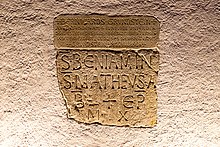Laying of the foundation stone



The foundation stone is in the construction a ceremony a (symbolic) foundation on which a new building is to be erected.
General
The custom of laying the foundation stone has always been found around the world. In the Bible a "corner stone" is mentioned in Psalm 118 , verse 22 ( Ps 118,22 EU ).
The laying of the foundation stone does not coincide with the actual start of construction - in most cases the start of the earthworks, i.e. the excavation of the construction pit - which is often celebrated with another ceremony: the groundbreaking or the first groundbreaking .
In a figurative sense, "foundation stone" is often used to emphasize something fundamental and indispensable for another issue.
Technical questions
The laying of the foundation stone is celebrated in particular for churches and public or semi-public buildings (such as town halls or administrative buildings ). A particularly artfully crafted foundation stone hammer is usually used , with which three symbolic blows are performed on the foundation stone with which consecration or blessings are pronounced too loud .
Foundation stones are often hollow and then contain a so-called " time capsule ", for example a soldered sheet metal vessel that can contain a certificate with details of the building project, evidence of the time such as current daily newspapers or coins and possibly other symbolic objects. Such foundation stones are usually walled in in the area of the foundation so that they can only be accessed again if the building is destroyed. An alternative to time capsules in foundation stones are tower balls , which are more easily accessible but also less protected.
Examples from history
- In prehistoric times until the late Middle Ages , building sacrifices were made on various occasions , the symbolic meaning of which is comparable.
- A ceremonial arrangement of the laying of the foundation stone has been handed down from ancient Egypt as early as the late Ptolemaic period. During the construction of the Temple of Hathor in Dendera, the ruler himself was responsible for making and setting the corner stone.
- The symbolic meaning of the foundation stone in the ancient world is also reflected in the frequent mention of “foundation stone” or equivalent “corner stone” in numerous biblical texts (Jer. 51,26; Rev. 21,14; Ps. 117,22; Mt 21, 41; Mk 12.10; Lk 20.17; Ap 4.11; 1Pred. 2,6 and 2,7)
- The foundation stone of an early church building in Hildesheim, St. Michael, dated 1010, has been preserved.
- The sculpture of Bishop Diederich III. von Isenburg , around 1230–1240, in the paradise porch of the cathedral in Münster is perhaps the only medieval statue of a donor holding a foundation stone.
- Occasionally a foundation stone with an inscription is inserted into the walls of the building above the ground level in such a way that it remains visible from the outside or inside. This type of foundation stone was used, for example, when Wilhelm II laid the foundation stone on October 11, 1900 for the reconstruction of the Saalburg Roman fort .
- There are also known cases in which the laying of the foundation stone as a symbolic start of construction - i.e. instead of a ceremonial (first) groundbreaking ceremony - was held at an early stage and the final construction work only began some time later, for example with the Düppel monument .
- In modern times, the trowels and hammers used by prominent participants to lay the foundation stone have been kept on various occasions, for example the silver trowel used by Bremen's mayor Johann Smidt and Senator Georg Gröning in 1828 when the chamber lock of the Old Port was founded in Bremerhaven , which was founded shortly before .
Individual evidence
- ↑ Othmar Keel: Die Welt der Altorientalischen Bildsymbolik, 5 1996, fig. 369 and 370.
- ↑ Illustration of a founder with a foundation stone
- ^ Alfred Löhr: Bremer Silber , exhibition catalog Focke-Museum Bremen 1981, p. 154.
See also
Web links
- Description of the laying of the foundation stone in 1928 on the website of the Johann-Heinrich-Pestalozzi-Gymnasium Rodewisch, last accessed on November 13, 2018.
- Tips on helpster.de , last accessed on August 9, 2017
